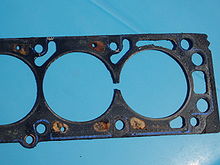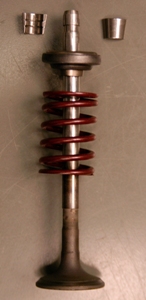
A poppet valve is a valve typically used to control the timing and quantity of petrol (gas) or vapour flow into or out of an engine, but with many other applications.
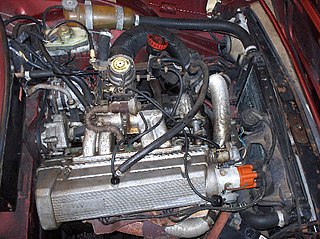
In internal combustion engines, exhaust gas recirculation (EGR) is a nitrogen oxide (NOx) emissions reduction technique used in petrol/gasoline, diesel engines and some hydrogen engines. EGR works by recirculating a portion of an engine's exhaust gas back to the engine cylinders. The exhaust gas displaces atmospheric air and reduces O2 in the combustion chamber. Reducing the amount of oxygen reduces the amount of fuel that can burn in the cylinder thereby reducing peak in-cylinder temperatures. The actual amount of recirculated exhaust gas varies with the engine operating parameters.
In spark-ignition internal combustion engines, knocking occurs when combustion of some of the air/fuel mixture in the cylinder does not result from propagation of the flame front ignited by the spark plug, but when one or more pockets of air/fuel mixture explode outside the envelope of the normal combustion front. The fuel–air charge is meant to be ignited by the spark plug only, and at a precise point in the piston's stroke. Knock occurs when the peak of the combustion process no longer occurs at the optimum moment for the four-stroke cycle. The shock wave creates the characteristic metallic "pinging" sound, and cylinder pressure increases dramatically. Effects of engine knocking range from inconsequential to completely destructive.

In a piston engine, the cylinder head sits above the cylinders, forming the roof of the combustion chamber. In sidevalve engines the head is a simple plate of metal containing the spark plugs and possibly heat dissaption fins. In more modern overhead valve and overhead camshaft engines, the head is a more complicated metal block that also contains the inlet and exhaust passages, and often coolant passages, Valvetrain components, and fuel injectors.

Top Fuel is a type of drag racing whose dragsters are the quickest accelerating racing cars in the world and the fastest sanctioned category of drag racing, with the fastest competitors reaching speeds of 338 miles per hour (544.0 km/h) and finishing the 1,000 foot (304.8 m) runs in 3.62 seconds.
Pre-ignition in a spark-ignition engine is a technically different phenomenon from engine knocking, and describes the event wherein the air/fuel mixture in the cylinder ignites before the spark plug fires. Pre-ignition is initiated by an ignition source other than the spark, such as hot spots in the combustion chamber, a spark plug that runs too hot for the application, or carbonaceous deposits in the combustion chamber heated to incandescence by previous engine combustion events.
A combustion chamber is part of an internal combustion engine in which the fuel/air mix is burned. For steam engines, the term has also been used for an extension of the firebox which is used to allow a more complete combustion process.
Internal combustion engine cooling uses either air or liquid to remove the waste heat from an internal combustion engine. For small or special purpose engines, cooling using air from the atmosphere makes for a lightweight and relatively simple system. Watercraft can use water directly from the surrounding environment to cool their engines. For water-cooled engines on aircraft and surface vehicles, waste heat is transferred from a closed loop of water pumped through the engine to the surrounding atmosphere by a radiator.
In a reciprocating engine, the cylinder is the space in which a piston travels.

In automotive engineering, an exhaust manifold collects the exhaust gases from multiple cylinders into one pipe. The word manifold comes from the Old English word manigfeald and refers to the folding together of multiple inputs and outputs.

Power Stroke, also known as Powerstroke or PowerStroke, is the name used by a family of diesel engines for trucks produced by Ford Motor Company and Navistar International for Ford products since 1994. Along with its use in the Ford F-Series, applications include the Ford E-Series, Ford Excursion, and Ford LCF commercial truck. The name was also used for a diesel engine used in South American production of the Ford Ranger.
Regenerative cooling, in the context of rocket engine design, is a configuration in which some or all of the propellant is passed through tubes, channels, or in a jacket around the combustion chamber or nozzle to cool the engine. This is effective because the propellants are often cryogenic. The heated propellant is then fed into a special gas-generator or injected directly into the main combustion chamber.

Hydrolock is an abnormal condition of any device which is designed to compress a gas by mechanically restraining it; most commonly the reciprocating internal combustion engine, the case this article refers to unless otherwise noted. Hydrolock occurs when a volume of liquid greater than the volume of the cylinder at its minimum enters the cylinder. Since liquids are nearly incompressible the piston cannot complete its travel; either the engine must stop rotating or a mechanical failure must occur.

The Bourke engine was an attempt by Russell Bourke, in the 1920s, to improve the two-stroke internal combustion engine. Despite finishing his design and building several working engines, the onset of World War II, lack of test results, and the poor health of his wife compounded to prevent his engine from ever coming successfully to market. The main claimed virtues of the design are that it has only two moving parts, is lightweight, has two power pulses per revolution, and does not need oil mixed into the fuel.

A crankcase ventilation system (CVS) removes unwanted gases from the crankcase of an internal combustion engine. The system usually consists of a tube, a one-way valve and a vacuum source.
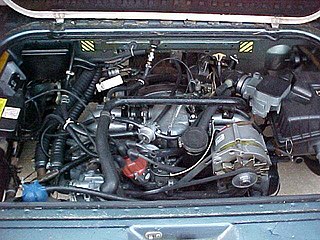
The Volkswagen wasserboxer is a four cylinder horizontally opposed pushrod overhead-valve (OHV) petrol engine developed by Volkswagen. The engine is water-cooled, and takes its name from the German: "wasserboxer" ("Water-boxer"); with "boxer" being another term for horizontally opposed engines. It was available in two displacements – either a 1.9-litre or a 2.1-litre; the 2.1-litre being a longer stroke version of the 1.9-litre, both variants sharing the same cylinder bore. This engine was unique to the Volkswagen Type 2 (T3), having never been used in any other vehicle. Volkswagen contracted Oettinger to develop a six-cylinder version of this engine. Volkswagen decided not to use it, but Oettinger sold a Volkswagen Type 2 (T3) equipped with this engine.

The Volkswagen D24 engine is a 2.4-litre inline-six-cylinder (R6/I6), naturally aspirated diesel engine, formerly manufactured by Volkswagen Group from 1978 to 1995.
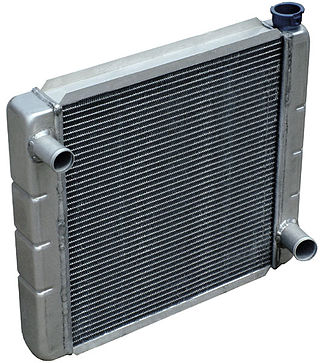
Radiators are heat exchangers used for cooling internal combustion engines, mainly in automobiles but also in piston-engined aircraft, railway locomotives, motorcycles, stationary generating plants or any similar use of such an engine.

An internal combustion engine is a heat engine in which the combustion of a fuel occurs with an oxidizer in a combustion chamber that is an integral part of the working fluid flow circuit. In an internal combustion engine, the expansion of the high-temperature and high-pressure gases produced by combustion applies direct force to some component of the engine. The force is typically applied to pistons, turbine blades, a rotor, or a nozzle. This force moves the component over a distance, transforming chemical energy into kinetic energy which is used to propel, move or power whatever the engine is attached to.

